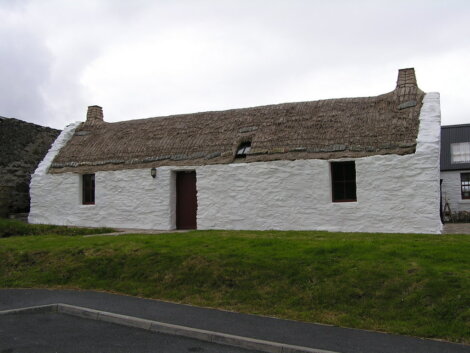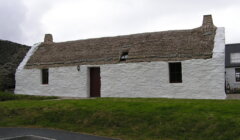Community / Proposal to temporarily remove thatched roof from historic crofthouse as condition worsens
THE THATCHED roof covering at a historic crofthouse in Burra could temporarily be removed amid concern about the building’s deteriorating condition.
The hope is that temporarily replacing the roof covering at Easthouse would halt water ingress while also buy time to consider the longer-term future of thatching in Shetland.
The historic croft house in Papil is owned by the Burra History Group, and it acts as a heritage centre which opens to the public during the summer.
It also features a barn, byre, pigsty and henhouse.
The A-listed crofthouse dates back to the mid 19th and early 20th century.
But its condition – exacerbated by the weather and primarily related to the deteriorating thatch roof – means it will not open this summer to the public, and the history group itself has had to use alternative premises.
Adalene Fullerton said the group has had to turn down a wedding and two bus tours this summer as well as a Wool Week booking.
She said a key problem is a change in climate – the prevailing wind used to be from the west, but is now from the east.
“The back of Easthouse is totally sheltered, and the front is 100 per cent exposed,” Fullerton said.
A feasibility study has been prepared by Malcolmson Architects to look at the options for the building’s future.
It has resulted in a planning application for the removal of the thatch and installation of new rafters plus a temporary metal sheeting roof, as well as replacement windows.
The study reiterated that weather has ultimately taken its toll on the building.
It added that the history group now encounters “serious problems caused by the burden and difficulties of annual maintenance, persistent water ingress, damage to both the building fabric and its contents, and ever-increasing running costs”.
Become a member of Shetland News
“The scale of the problem, largely caused by the deteriorating thatch roof, now means that the level of maintenance required has become untenable.”
Fullerton said the group pays a high amount of insurance mainly due to the straw roof and a fear of fire.
“You could use wir straw to put a fire out, you could never use it to start a fire,” she said. “It’s just soaking wet.”
The report says the “demoralised” group – which has occupied the crofthouse since 2006 – is “now seriously reviewing the situation and have reached the conclusion that they can no longer continue as custodians of this building in its current form”.
One particular problem is said to be the lack of local skills and materials for annual repairs and re-roofing.
By 2019 the croft house was only one of five buildings, or groups of buildings, known in Shetland to have an intact thatched roof – another being the Crofthouse Museum in the South Mainland, which is run by Shetland Amenity Trust.
The roof at Easthouse is a replica using traditional Shetland thatching techniques.
The feasibility study says that while the straw thatch adds character to the building, “much of the special architectural interest is due to the rare survival of a 19th century Shetland crofting settlement and the historic interest from the carefully recreated traditional construction methods in the build-up of the roof”.
“As a whole this is of greater long-term interest than the actual thatch itself, which needs to be replaced on a 2-3 yearly cycle.”
The traditional material for thatching in Shetland is oat straw, or Shetland aets, but there are said to be only a few people growing it and there is no guarantee of supply – with insufficient quantity to rethatch both the Crofthouse Museum and Easthouse.
The building was repaired and restored between 2001 and 2006 using traditional materials where possible, and the process was even featured on a national BBC TV show.
It was lived in permanently until 1972 before it was occupied by oil terminal construction workers and then holidaymakers until the 1980s, and then it was empty prior to the history group taking it on.
The study said in recent years there has been more stormy weather from the south-east, from where there is less shelter, while there are also “wetter winters”.
History group volunteers are left having to mop the floor regularly, prepare buckets to catch leaks and empty dehumidifiers.
Consultations on the property’s future have been held with Historic Environment Scotland, Shetland Amenity Trust and Shetland Islands Council.
Four options were created off the back of these meetings, including replacing the thatch with a permanent roof covering.
However the preferred option is a five-year temporary solution where only the straw covering is removed and a new waterproof “hat” is constructed to protect the building.
It is said this would allow time for heritage organisations to develop a long-term strategy for sourcing traditional thatching materials and training craftsmen.
It would also allow the history group to continue to use the building without concerns over water leaks and damage.
The smaller byre and pigsty also have thatched roofs, in equal or worse conditions, but it is proposed to keep these coverings with a view to repairing and maintaining them.
There may be the opportunity to use the byre and pigsty for training of roof thatching skills.
Malcolmson Architects said in its conclusion that through collaboration with others including the amenity trust and Historic Environment Scotland, the crofthouse in the future could become an “invaluable resource for training purposes and conservation of thatching skills”.
Become a member of Shetland News
Shetland News is asking its many readers to consider paying for membership to get additional features and services: -
- Remove non-local ads;
- Bookmark posts to read later;
- Exclusive curated weekly newsletter;
- Hide membership messages;
- Comments open for discussion.
If you appreciate what we do and feel strongly about impartial local journalism, then please become a member of Shetland News by either making a single payment, or setting up a monthly, quarterly or yearly subscription.
































































